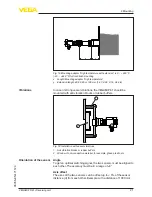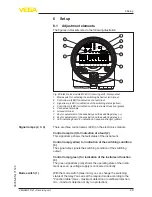
35
7 Maintenance and fault rectification
VEGAMIP R61 • Receiving unit
35786-EN-171120
7 Maintenance and fault rectification
7.1 Maintenance
If the instrument is used correctly, no maintenance is required in
normal operation.
7.2 Rectify faults
The operator of the system is responsible for taking suitable meas-
ures to rectify faults.
The first measure to take is to check the output signal. In many cases,
the causes can be determined this way and the faults quickly rectified.
Error
Cause
Rectification
VEGAMIP 61 signals
"covered" without being
submerged (overfill pro
-
tection)
or
VEGAMIP 61 signals "un-
covered" when being
submerged (dry run pro-
tection)
Operating voltage too low Check operating voltage
Buildup on the sensor
Check if there is buildup on the two sensors, and if so,
remove it.
Note the instructions in chapter "
Mounting
" if there is
buildup in the socket.
Wrong mode selected
Set the correct mode on the mode switch (max.: over-
flow protection, min.: dry run protection). Wiring should
be carried out according to the idle current principle.
Unfavourable installation
location
Mount the sensor (emitter/receiver) at a location where
there is a large quantity of measured product between
the emitting and receiving units.
Mount the sensor (emitter/receiver) at a location where
there are no interfering installations or moving parts.
Electronics defective
Press the mode switch. If the instrument then does not
change the mode, the electronics module may be de-
fective. Exchange the electronics module.
Sensor defective
Operate the mode switch (min./max.). If the instrument
then switches mode, the sensor may be covered with
buildup or mechanically damaged.
If the switching function in the correct mode is faulty, re-
turn the instrument for repair.
Signal lamp lights red
Operating voltage too low Check operating voltage
Electronics module has
detected an internal mal-
function
Exchange the instrument or send it in for repair
Instrument switches de-
layed
Check switching delay
Adjust switching delay correctly
Instrument switches fre-
quently with certain levels
Wave movements in the
vessel
Adjust or increase switching delay
Effects through interfering
reflections
Adjust the instrument to less sensitive
Reaction when malfunc-
tion occurs
Fault rectification
Checking the switching
signal














































